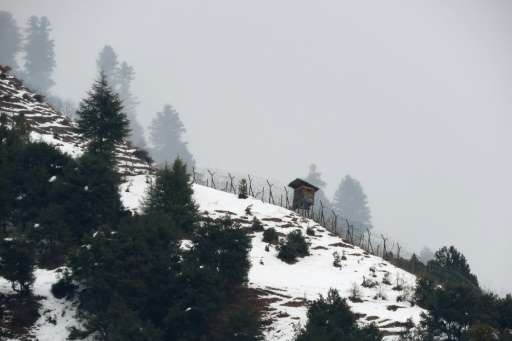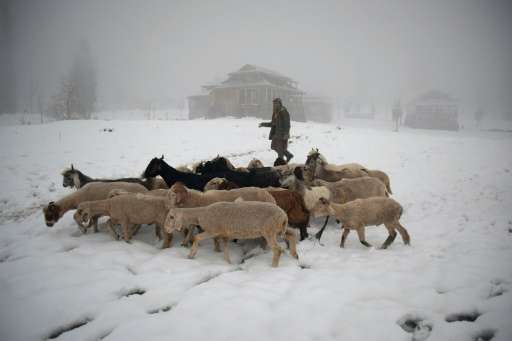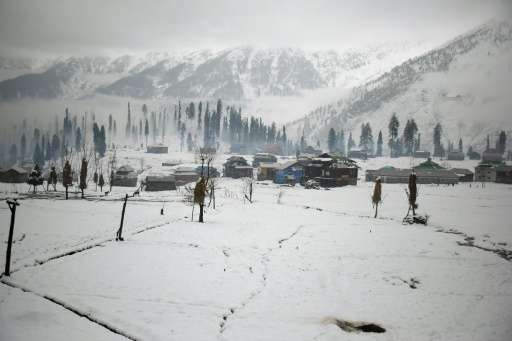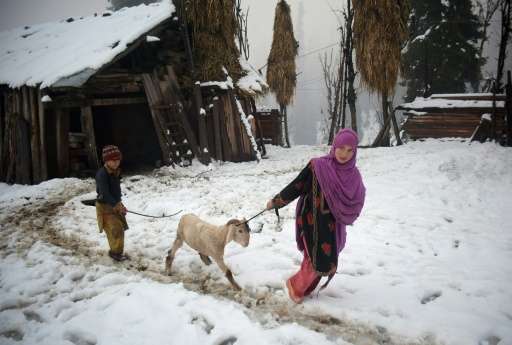Fenced in: The Kashmir barrier that is endangering wildlife

A double row of fence and tangled concertina wire curves like a Frankenstein stitch across the Kashmir frontier, blocking anything that might try to cross one of the world's most dangerous flashpoints—including, environmentalists say, migrating wildlife.
Built in 2007 by India, the impenetrable barrier scarring hundreds of kilometres of snowy forests has obstructed militants from neighbouring Pakistan for years, but it has also halted the movement of some spectacular and rare species formerly abundant in the area, wildlife officials have told AFP.
Creatures such as black bears and leopards, fenced in on the Pakistani side, are being driven by hunger into nearby settlements, often with fatal consequences.
In the lush hilltop hamlet of Arang Kel, more than 8,000 feet (2,500 metres) above sea level, residents say they have no choice but to kill the wild animals stalking their land.
"Our cattle, sheep, goats and cows are not safe from them and sometimes they attack people," villager Roshan Khan, who is in his 60s, tells AFP. "That's why they are being killed."
"They have to travel towards human settlements in search of food, where they are killed by people when they attack their livestock," says Yousuf Qureshi, the former director of the wildlife department in Pakistani Kashmir.

Since 2007 around 35 common leopards, five bears, and several brown bears have met their fate this way, says Pakistani Kashmir assistant wildlife and fisheries department director Naeem Dar.
The detour, exacerbated by deforestation and coupled with a lack of resources available to wildlife officials, has contributed to the eradication of many such species on the Pakistani side of the Line of Control (LoC), officials say.
'Tragedy'
The electric fence stands up to twelve feet tall in places, and is attached to an elaborate network of motion sensors, thermal imaging devices, lighting systems and alarms. The area immediately around it is peppered with land mines—all in a bid to protect the frontier from infiltration by militants.
Kashmir's thick forests and soaring slopes are divided between bitter nuclear-armed neighbours Pakistan and India along the de facto border agreed on in a 2003 ceasefire, but claimed by both in full. Two of their three wars since independence have been fought over the region.
The Srinagar-based commander of the Indian army's XV Corps, Lt Gen S K Dua, tells AFP the flow of militants crossing over from Pakistan-administered Kashmir is "down to a trickle" now, crediting the formidable fence and other counter-insurgency initiatives.

But, while blocking militants—and wildlife—from Pakistan, the barrier has also prevented animals moving from the Indian side.
Creatures such as the markhor, a type of wild goat with majestic horns, simply no longer appear on the Pakistani side—blocked by hundreds of kilometres of barbed wire and explosives, says Qureshi.
"(The markhor) would travel from Pir Panjal (in the Himalayan mountains in Indian-held Kashmir) to Neelum Valley, but the fence created a barrier and their migration has ended," he says. "This is a tragedy."
The same goes for the hangul, or Kashmir deer, once common in the area but now "totally extinct" on Pakistan's side of the border, he says.
Tear down this fence
The fence itself is not the only issue, Qureshi warns. The barrier has not stopped regular instances of firing by soldiers on both sides across the LoC which, he says, which has also driven wildlife away.

"Once they abandoned their habitats they did not go back," he says.
Deforestation also plays a significant role. Neelum Valley winters are harsh, with wood the only fuel for villagers bereft of electricity or other sources of power.
When India and Pakistan were created in 1947 forest covered some 24 percent of Pakistani Kashmir, but that has now dropped to 11 percent.
"The natural living places of these animals are being destroyed," says Munawaar Hussain, a wildlife employee posted in Arang Kel.
For Muhammad Arshad, district programme manager for the Himalaya Welfare Organization, the problem is clear: the area needs peace.
"Fencing on the LoC has disturbed their natural habitat and limited the territory," he says.
"India and Pakistan should have peace in the region and dismantle the fencing on the LoC for the conservation of these species," adds Qureshi.
For now, villagers in Arang Kel say they have no choice but to keep killing the animals—despite the threat of fines and imprisonment for illegal hunting.
"We are worried the wildlife department will lodge a case against us when we kill these animals," says villager Khan.
"There must be some solution."
© 2016 AFP



















